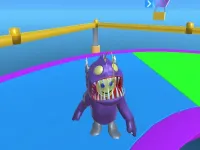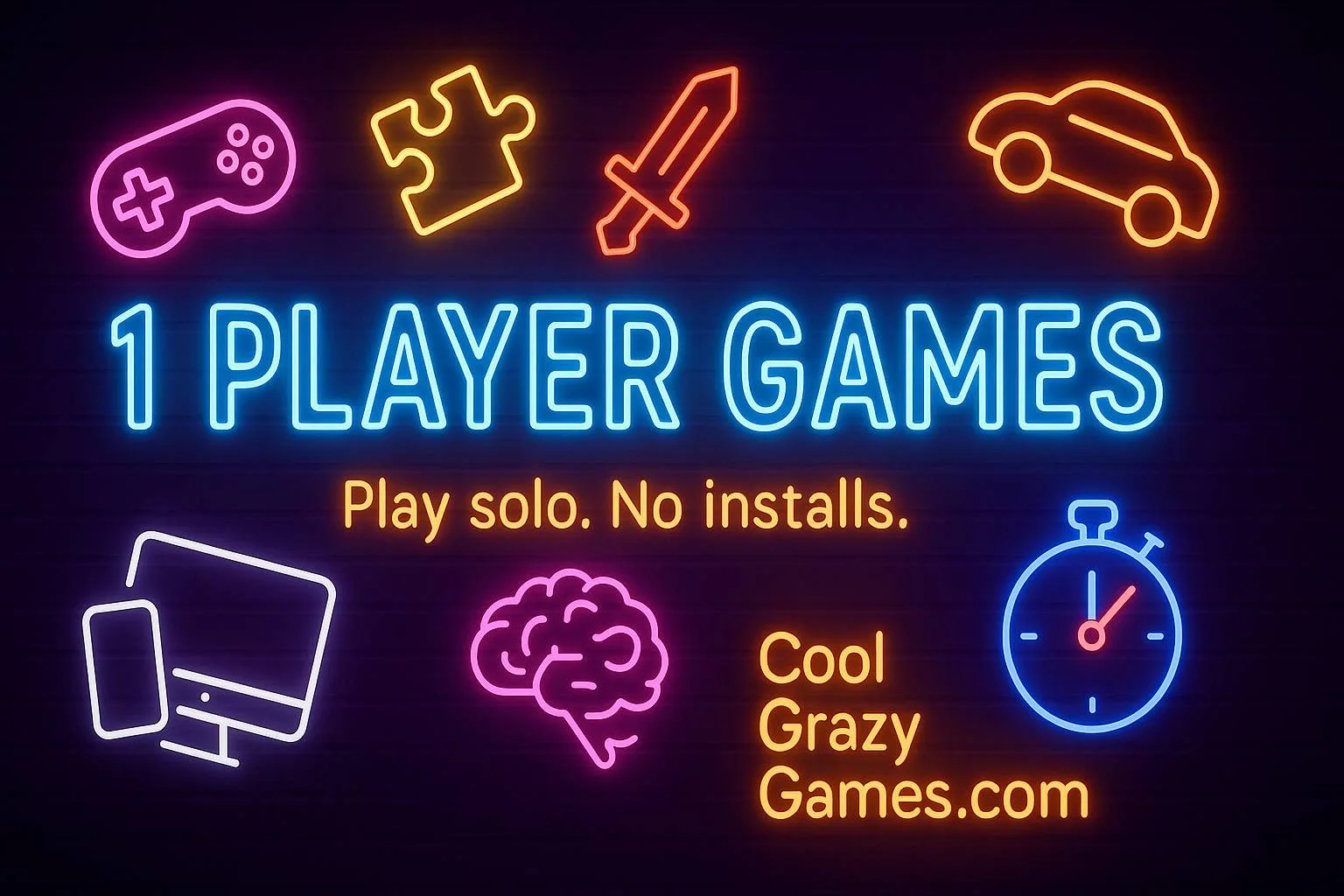
Fall Guys Unblocked Web Multiplayer

Online Cats Multiplayer Park

Labubu and Friends 2Player

Snake War Multiplayer

SquidGame Multiplayer

Helicopter Battle Steve 2 Player

Sprunki Happy Easter 2Player

Gorilla Multiplayer

Sprunki Lava Escape 2Player

2Player Tanks of War

Bus Transport Footbal Players

MCraft TNT 2 Player Game

1 2 3 4 Player Tank Game 2D

Sprunki 2Players Billiard

Tank Soccer Battle 1 2 3 4 Player

When you search 1 player games, you’re really asking for two things: instant fun and full control. No matchmaking delays, no team drama—just you, a clear objective, and a tight gameplay loop that rewards skill from the very first run. Modern browser tech delivers exactly that: focused, solo-friendly experiences that launch in a click, run smoothly on any device, and make it easy to squeeze a satisfying session into a break, a commute, or a late-night wind-down.
Play 1 player games now on https://www.coolcrazygames.com by clicking here: 1 player games.
In this definitive 2025 playbook, you’ll learn what “1 player games” means today, how to choose the perfect sub-genre for your mood, and the step-by-step routines that turn short attempts into long streaks. We’ll break down platformers, puzzles, runners, shooters, strategy, racing, simulation, and more—with beginner tips, advanced tricks, and pro-grade mindset tweaks. By the end, you’ll have a solo toolkit you can drop into any 1-player title and immediately start improving.
At a high level, 1 player games are titles designed for a single person to play from start to finish—no co-op required, no online opponents needed. They emphasize clarity (simple rules, readable goals), control (you set the pace), and mastery (skill and planning drive progress). Browser-first releases make these experiences even more accessible: they load fast, restart instantly, and work across laptop, desktop, tablet, or phone.
Formally, you can think of this space as the union of a play style and a delivery platform—as defined by Single-player video game and Browser game.
While every title is different, the learning curve is remarkably consistent. Use this universal, 6-step routine to feel comfortable fast and ramp your skill in minutes—not hours.
Before your first attempt, identify three things:
Goal: reach the exit, survive waves, solve the board, beat the timer, or rack up points.
Lose condition: health to zero, falling off, time expired, incorrect move, or single-hit fail.
Controls: keys/buttons/touches you’ll use 90% of the time (e.g., move, jump, interact, shoot, rotate, place, undo).
This 30-second scan prevents “mystery deaths” and lets you focus on timing instead of guessing.
Your first 60–90 seconds are for information, not score:
Cycle lengths: how often do hazards or enemies repeat?
Safe space: tiles, platforms, or sidelines where you can re-center.
Camera habits: side scroller, top-down lane view, or fixed board—each needs different eye tracking.
Games reward tempo even more than raw reaction time:
Count “one-and-two-and” under your breath; move/act on the same sub-beat each time.
Prefer taps to long presses for consistent spacing and jump heights.
If you desync, stop for half a beat—then rejoin the pattern.
Create a tiny script you repeat at the start of every run:
Platformers: center camera → safe hop cadence → checkpoint.
Runners: middle lane → clean first gap → ignore risky coins.
Puzzles: establish edges/corners or guaranteed moves before combos.
Shooters: strafe rhythm → burst fire → emergency dash bound to muscle memory.
Strategy/Sim: early upgrade loop (economy → defense → expansion).
This opener gets you past the boring early deaths and into the “real” game.
When plans collapse, don’t improvise—default:
Re-center (middle platform, safe lane, empty cell).
Block up/down (in buildy/voxel titles).
Shield/dash (if supported) to reset spacing.
Pause for half a beat to restore your internal metronome.
After a fail, name exactly one cause: “turned early,” “greedy pickup,” “jumped on wrong beat,” “forgot exit path.” Fix just that next run. This tiny habit compounds into real mastery.
Below are genre-by-genre techniques you can apply across most 1 player games. Each starts with quick wins, then adds expert polish.
Quick wins
Edge timing > button mashing. Launch jumps at the last pixel for extra distance without extra risk.
Two-step settle. After a long jump, take two micro-steps to stabilize your next input.
Camera hygiene. Keep your avatar in the center third; seeing a few tiles ahead extends reaction time.
Advanced polish
Coyote time saves. Many games allow a micro-window to jump after you leave a ledge—practice it deliberately.
Buffering. Press jump during landing frames if the rules allow; you’ll chain jumps smoothly.
Momentum steering. Adjust the camera mid-air to line up the next platform before your feet touch down.
Quick wins
Guaranteed progress first. Clear edges/corners, break blockers, or place fixed numbers before chasing combos.
Three-move lookahead. If your move doesn’t set up the next two, pick another.
Advanced polish
End-state backsolves. Visualize the solved board and work backward to force the only path that makes it.
Combo banking. Build cascades, then delay the trigger until they clear obstacles or unlock multipliers.
Symmetry breaks. When stuck, rotate the board in your head and search for asymmetries you missed.
Quick wins
Read patterns, not objects. Treat the world as lanes that open and close on a beat.
Greed caps. Decide a maximum reach for coins/boosts; anything farther is bait.
Advanced polish
Micro-pauses. Insert a 0.1–0.2s settle after a risky dodge to resync your rhythm.
Double commitment. Commit to two moves at once (e.g., “left then jump”) to avoid late corrections.
Quick wins
Strafe rhythm. Rock left-right as your default; break pattern only to bait incoming fire.
Burst fire. Five-to-seven-round bursts maintain accuracy and ammo economy.
Advanced polish
Corner slicing. Peek with millimeters of silhouette; shoot; retreat; re-peek on a fresh angle.
Threat triage. Kill fast movers, AoE lobbers, and buffing enemies first; they destabilize your plan.
Quick wins
Economy first. Early upgrades that produce resources per second or per wave usually snowball best.
One choke, one reserve. Build a reliable choke point and keep a small emergency fund for leaks.
Advanced polish
Spike timing. Stack burst DPS at waves with high-HP elites; steady DPS handles trash mobs.
Tempo control. Trigger waves only when cooldowns are ready and your economy tick just landed.
Quick wins
Brake in a line, steer once. Finish most braking before turn-in; minimal steering preserves speed.
Exit speed pays. Early throttle at apex beats late-brake heroics.
Advanced polish
Trail brake rotation. Feather the last 10–20% of brake to help the nose rotate, then unwind as you roll on.
Two markers you trust. Pick braking/turn-in references you never miss (a shadow, a sign, a fence post).
Quick wins
Scaffold stack. Carry cheap blocks solely for temporary paths; reclaim later to keep inventory lean.
Symmetry first. Rough-in the frame (walls, roof) before detail passes; you’ll feel progress faster.
Advanced polish
Panelize big builds. Split projects into 5×5 or 7×7 panels; complete one per session to avoid overwhelm.
Safety loop. Light the perimeter, mark a return path, and stash backup tools before exploring.
Quick wins
Offline earnings first. Anything that pays while you’re away multiplies the value of short sessions.
Upgrade synergies. Combine multiplicative buffs rather than stacking additive ones.
Advanced polish
Prestige math. Reset when the time to next milestone exceeds the time to prestige and rebuild.
Plateau scans. If progress stalls, check for a cheap unlock gating a new multiplier.
Short loops, big feedback. Every input pops: a clean jump, a solved tile, a perfect apex. Immediate feedback is addictive.
Fair losses. You usually know why you failed—too early, too late, too greedy—which triggers that powerful “I can fix this” feeling.
Instant restarts. One key or tap and you’re back in. Zero downtime keeps the learning loop hot.
Flexible sessions. Five minutes works, fifty minutes works. Your schedule sets the pace.
Transparent mastery. Better results come from better decisions, not purchases. That sense of agency keeps you returning.
Solo flow state. Without teammate noise, it’s easier to enter deep focus and feel those perfect, timeless runs.
Note: This section includes only same-domain links auto-discovered from the site’s sitemaps (/blog, /game, /home/keyword). If none can be reliably fetched, the section is intentionally omitted to keep links clean and accurate.
When your goal is to sharpen skills and play solo, friction is the enemy. CoolCrazyGames optimizes for what single-player fans value most:
Instant play, no installs. Click, learn a one-screen rule set, and start your first run.
Mobile + desktop friendly. Touch, mouse, or keys—snappy input with readable UI scaling.
Clean categories. Clear tags (action, puzzle, racing, platform, .io, idle, etc.) make it easy to match your mood.
Fast restarts. Lightweight pages reduce downtime so you get more reps per minute.
Curated variety. A steady rotation of solo-friendly games—quick sprints for breaks and deeper skill ladders for longer sits.
Focus-first UX. Legible fonts, sensible layouts, and minimal clutter keep your eyes on the playfield.
Jump in now and play 1 player games on https://www.coolcrazygames.com: 1 player games.
1 player games are the purest form of play: you, the rules, and a loop that tells you—instantly—whether your idea worked. With a 30-second rule scan, a simple internal beat, a 90-second opener, and the “one fix per death” ritual, you can feel progress within a single session. The browser makes it effortless: no installs, no waiting, no problem.
Pick a genre that fits your mood—platformer, puzzle, runner, shooter, strategy, racing, builder, or idle—and apply the tips above. If your first few minutes feel cleaner, you’re on the right path. Your next personal best is one focused run away.
Q1) What exactly counts as a “1 player game”?
Any title designed to be fully playable solo—from tiny puzzle loops to long-form adventures. Some games also offer optional modes (time trials, endless, hard variants) that elevate solo replayability.
Q2) Do I need to download or sign up to play?
No. These are browser-first experiences: open a tab and start. Many feature save systems or level select that work without accounts.
Q3) I only have 10 minutes—what’s the fastest way to improve?
Run three focused attempts with one micro-goal each (e.g., “re-center after risky jumps,” “count the beat,” “only safe coins”). State the exact cause of each fail and fix one thing next run.
Q4) Keyboard, controller, or touch—what’s best for solo play?
Whatever you’ll practice consistently. Keyboard excels at on/off precision; controller shines with analog inputs; touch is great for runners and tap-timers. Consistency beats hardware.
Q5) I tilt after a bad run—any mindset tips?
Do a 10-second reset: exhale, drop your shoulders, blink twice, and release on the next full beat. Pick one change. Tilt fades when you control tempo.
Q6) How do I beat puzzle plateaus?
Switch perspectives: back-solve from the end state, look for symmetry breaks, or set a hard rule like “every move must create two new options.”
Q7) Are 1 player games pay-to-win?
Generally no. Performance comes from better timing, reads, and planning—not purchases. If upgrades exist, they’re usually earned by play, not pay.
Q8) What settings help with focus or accessibility?
Enable reduced screen shake, color-blind friendly palettes, larger UI, and SFX on / music off for cleaner timing cues. Brighten the screen a notch for clearer edges.
Q9) How do I choose the right genre for my mood?
Need calm? Try puzzles or builders.
Want flow? Runners or platformers.
Crave intensity? Shooters or strategy roguelikes.
Short bursts? Racing time trials or idle check-ins.
Q10) Where do I start right now?
Open the tag page and pick your first challenge: 1 player games. Apply the rhythm and opener techniques above—you’ll feel improvement in minutes.